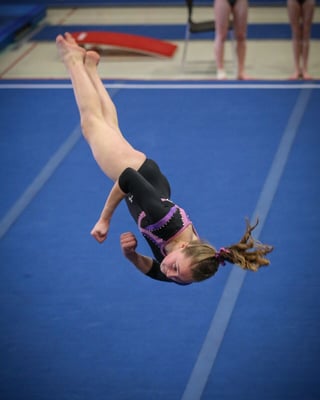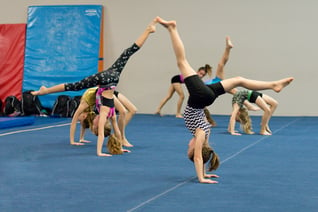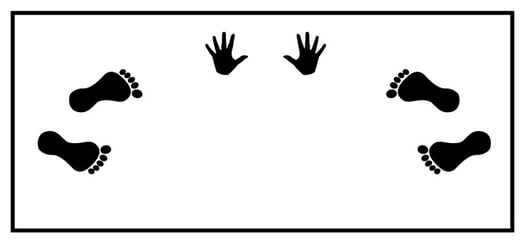Picture it, your child runs out of class and excitedly tells you all about the new skill they have learned. You are excited for them, but haven't the slightest idea what they are talking about. No worries, Pinnacle is here to help! This month's issue of Parent Connection is all about the Floor!
Gymnastics is a sport of skills, many of which have unique names. Combine the names with the different apparatus and you may have a bit of research ahead of you. Below you will find some basic floor terminology, common floor skills, and even a DIY project to help your aspiring gymnast.
The Basics of the Floor Exercise 
The floor exercise or floor, is a gymnastics event that incorporates tumbling skills and dance elements. In Women’s gymnastics, the floor routine is set to music. Floor requires both strength and power to achieve the great tumbling skills but also showcases the grace and flexibility of a gymnast through the dance skills. The floor area is a square measuring 39 feet by 39 feet. The diagonals are about 55 feet long. Most floors are spring floors which help to soften the impact of the landings and also help the gymnast gain more height.
Requirements of a floor routine include tumbling passes, jump or leap series and turns. Here are the parts broken down:
- Tumbling passes typically connect 2 or more acro skills and are performed on the diagonal of the floor. Skills required may be forward and backward.
- Jump or leap series are a connection of multiple jumps or leaps.
- Turns on one foot are required on most floor routines and may require higher degrees of rotations.
These basics will help you understand what you are watching during the floor routine, and help you understand what a competitive gymnast may be talking about. Routines, however, are not generally used for a basic recreational class.
Gymnastics Terminology for the Floor Exercise 
Unlike a routine, all gymnasts do participate in various floor skills, from preschoolers to our upper level team gymnasts. These skills do vary, but many start with the same core skill. Here are some of the most common skills, along with their definition:
- Tuck: From a seated position, hug knees to chest.
- Rock & Roll: In tuck position, rock on your back and roll back up to seated tuck.
- Forward Roll: Stand with arms over head, tuck chin to chest, reach forward to floor, tuck body, roll and return to standing position.
- Flapjack: Lay on back with head on end of a block, arms straight out, hands on floor, bend at waist, bringing feet over head to floor, stand up.
- Backwards Roll: Start in a squat, hands close to body with palms flat towards ceiling, roll back while lifting legs straight and over head, put feet on ground and continue to upright position.
- Cartwheel Hops: Placing hands on a prop like a block, learning to support body weight while hopping feet from one side to another.
- Cartwheel: Begin in lunge, arms up, front leg bent slightly, back leg straight, weight evenly distributed. Gradually reach forward, with the arm on the same side as your bent leg while bringing the back leg up. Kick with your back leg as you place the other hand down. Straddle legs in a V shape. Landing in reverse order.
- Roundoff: Same as cartwheel with the modification of bringing feet down together on the landing.
- Handspring/Back Handspring:A fast movement in which you jump forward or backward, land on your hands, swing your legs up and over your body, and then land on your feet.
Quick DIY Project for your Gymnast on Floor
There is no denying that a cartwheel is an important skill in gymnastics! Create your own cartwheel mat to help your young gymnast perfect this skill at home!
Simply draw on feet and hands on a cheap yoga mat and you are all set. Click here for more detailed directions!

Hopefully, with a little knowledge, the sport of gymnastics will become one of your favorite sports for both you and your gymnast! It is a sport that changes through the years and seeing success through your child can be one of the best experiences available.


